Business Law Assignment: Analyzing Negligence and Contract Scenarios
VerifiedAdded on 2021/05/31
|12
|2361
|57
Homework Assignment
AI Summary
This business law assignment analyzes various scenarios involving negligence and contract law. The first scenario explores a professional tax advisor's liability for negligent misstatement, considering the duty of care and the "but for" test. The second scenario examines the negligence of multiple parties in a bike accident, including the bike provider, the driver, and the injured individual, applying the Caparo test and considering contributory negligence. The second part of the assignment delves into contract law, addressing issues such as breach of contract due to revocation of offer, incorporation of contractual terms, the application of promissory estoppel, and the validity of a guarantee based on unconscionable conduct. The assignment applies relevant legal principles and case law to provide reasoned conclusions for each scenario.
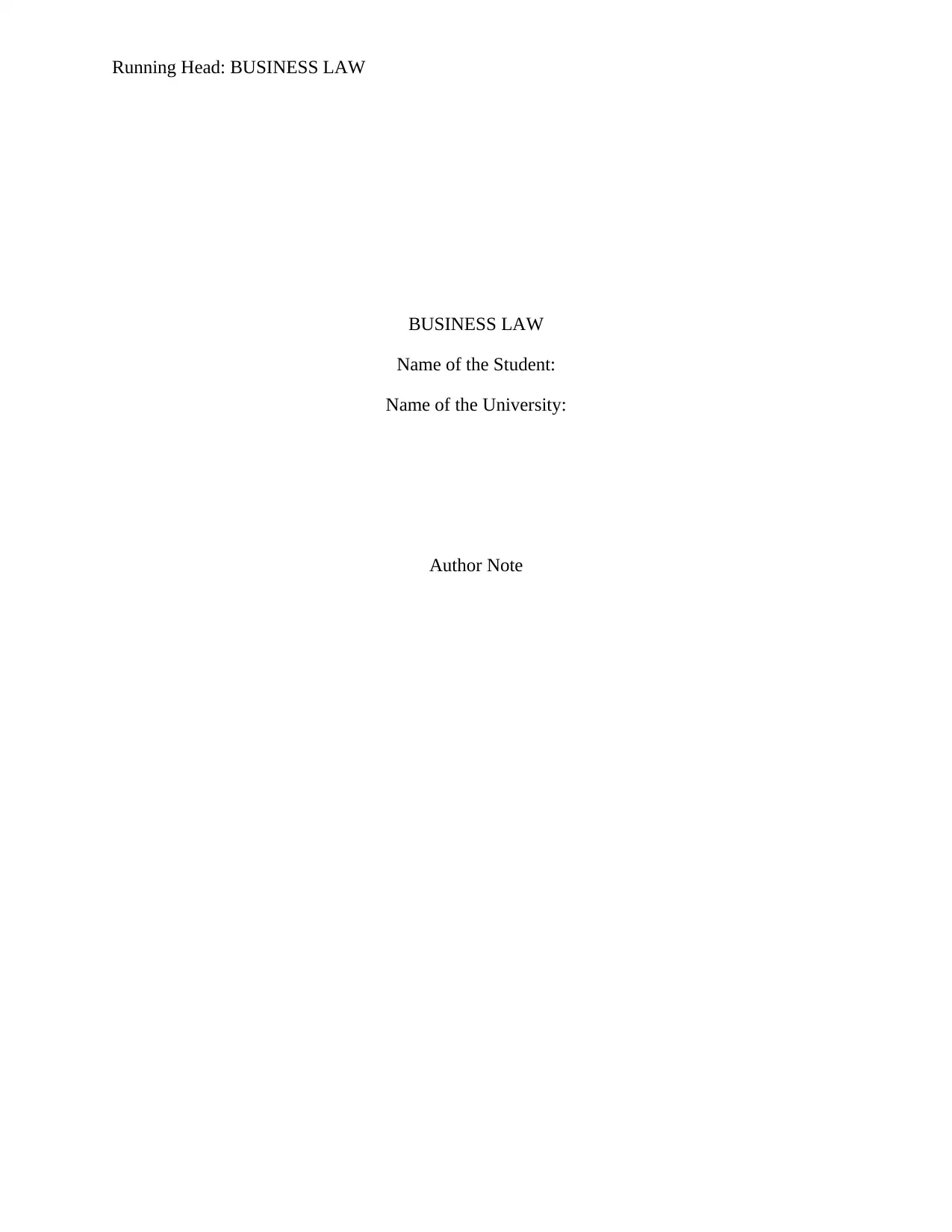
Running Head: BUSINESS LAW
BUSINESS LAW
Name of the Student:
Name of the University:
Author Note
BUSINESS LAW
Name of the Student:
Name of the University:
Author Note
Paraphrase This Document
Need a fresh take? Get an instant paraphrase of this document with our AI Paraphraser
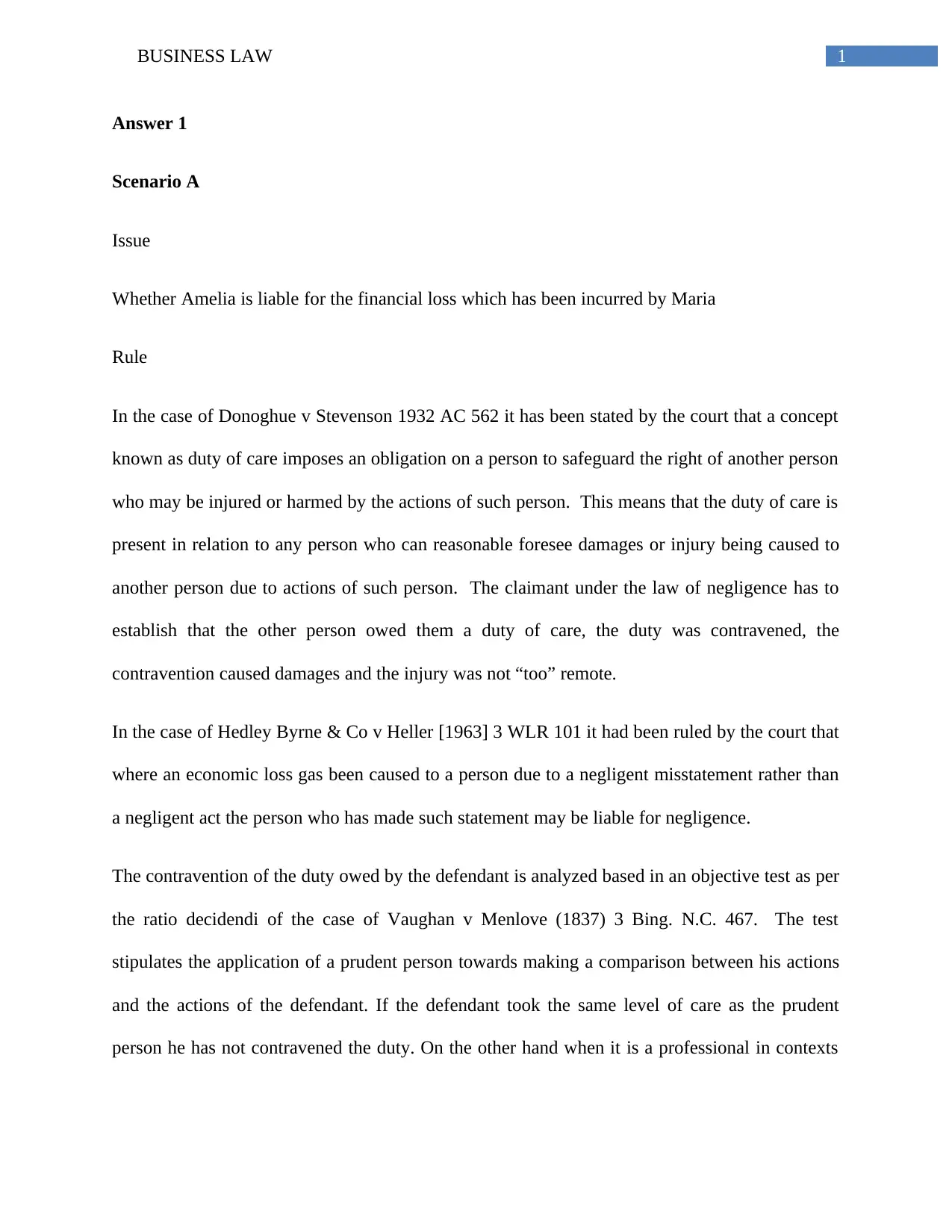
1BUSINESS LAW
Answer 1
Scenario A
Issue
Whether Amelia is liable for the financial loss which has been incurred by Maria
Rule
In the case of Donoghue v Stevenson 1932 AC 562 it has been stated by the court that a concept
known as duty of care imposes an obligation on a person to safeguard the right of another person
who may be injured or harmed by the actions of such person. This means that the duty of care is
present in relation to any person who can reasonable foresee damages or injury being caused to
another person due to actions of such person. The claimant under the law of negligence has to
establish that the other person owed them a duty of care, the duty was contravened, the
contravention caused damages and the injury was not “too” remote.
In the case of Hedley Byrne & Co v Heller [1963] 3 WLR 101 it had been ruled by the court that
where an economic loss gas been caused to a person due to a negligent misstatement rather than
a negligent act the person who has made such statement may be liable for negligence.
The contravention of the duty owed by the defendant is analyzed based in an objective test as per
the ratio decidendi of the case of Vaughan v Menlove (1837) 3 Bing. N.C. 467. The test
stipulates the application of a prudent person towards making a comparison between his actions
and the actions of the defendant. If the defendant took the same level of care as the prudent
person he has not contravened the duty. On the other hand when it is a professional in contexts
Answer 1
Scenario A
Issue
Whether Amelia is liable for the financial loss which has been incurred by Maria
Rule
In the case of Donoghue v Stevenson 1932 AC 562 it has been stated by the court that a concept
known as duty of care imposes an obligation on a person to safeguard the right of another person
who may be injured or harmed by the actions of such person. This means that the duty of care is
present in relation to any person who can reasonable foresee damages or injury being caused to
another person due to actions of such person. The claimant under the law of negligence has to
establish that the other person owed them a duty of care, the duty was contravened, the
contravention caused damages and the injury was not “too” remote.
In the case of Hedley Byrne & Co v Heller [1963] 3 WLR 101 it had been ruled by the court that
where an economic loss gas been caused to a person due to a negligent misstatement rather than
a negligent act the person who has made such statement may be liable for negligence.
The contravention of the duty owed by the defendant is analyzed based in an objective test as per
the ratio decidendi of the case of Vaughan v Menlove (1837) 3 Bing. N.C. 467. The test
stipulates the application of a prudent person towards making a comparison between his actions
and the actions of the defendant. If the defendant took the same level of care as the prudent
person he has not contravened the duty. On the other hand when it is a professional in contexts
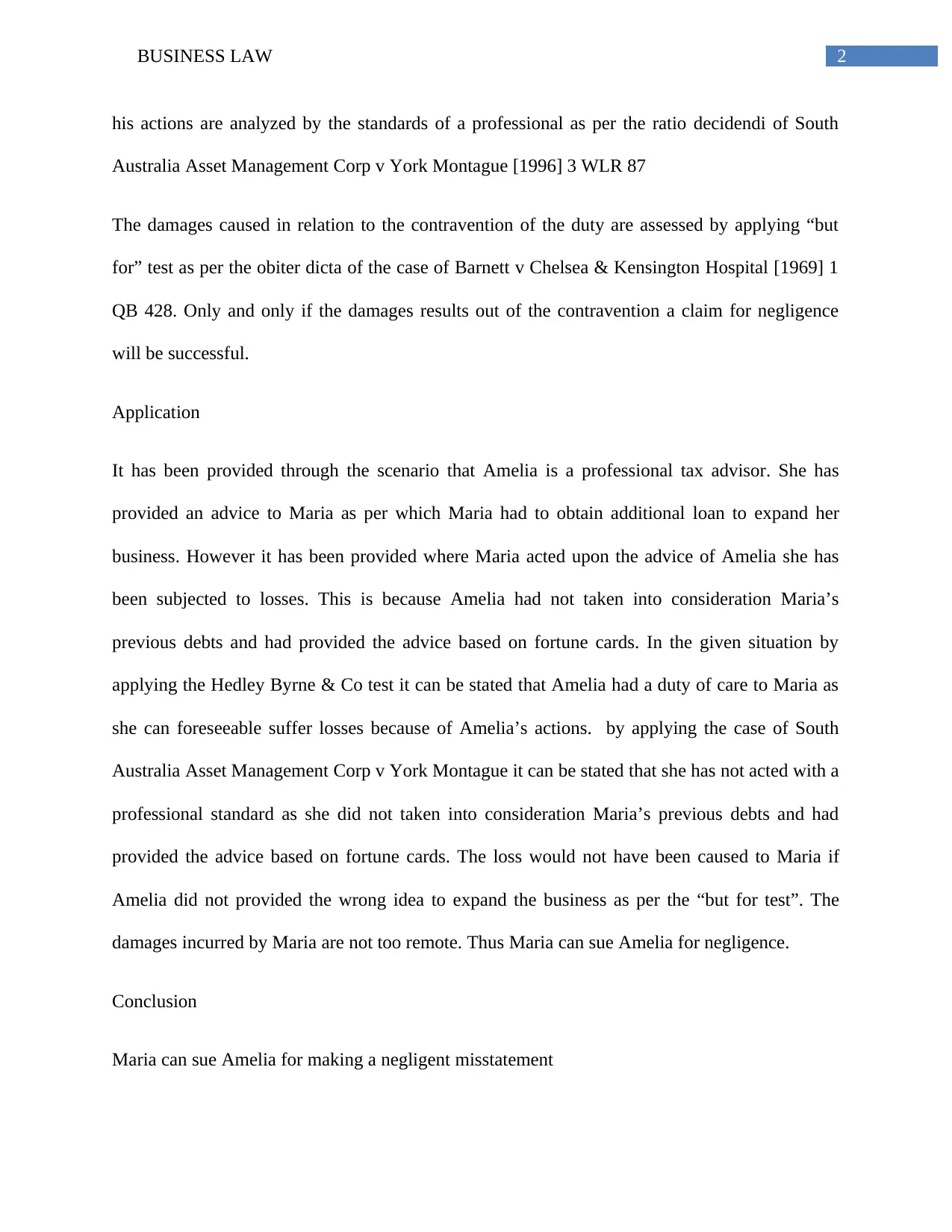
2BUSINESS LAW
his actions are analyzed by the standards of a professional as per the ratio decidendi of South
Australia Asset Management Corp v York Montague [1996] 3 WLR 87
The damages caused in relation to the contravention of the duty are assessed by applying “but
for” test as per the obiter dicta of the case of Barnett v Chelsea & Kensington Hospital [1969] 1
QB 428. Only and only if the damages results out of the contravention a claim for negligence
will be successful.
Application
It has been provided through the scenario that Amelia is a professional tax advisor. She has
provided an advice to Maria as per which Maria had to obtain additional loan to expand her
business. However it has been provided where Maria acted upon the advice of Amelia she has
been subjected to losses. This is because Amelia had not taken into consideration Maria’s
previous debts and had provided the advice based on fortune cards. In the given situation by
applying the Hedley Byrne & Co test it can be stated that Amelia had a duty of care to Maria as
she can foreseeable suffer losses because of Amelia’s actions. by applying the case of South
Australia Asset Management Corp v York Montague it can be stated that she has not acted with a
professional standard as she did not taken into consideration Maria’s previous debts and had
provided the advice based on fortune cards. The loss would not have been caused to Maria if
Amelia did not provided the wrong idea to expand the business as per the “but for test”. The
damages incurred by Maria are not too remote. Thus Maria can sue Amelia for negligence.
Conclusion
Maria can sue Amelia for making a negligent misstatement
his actions are analyzed by the standards of a professional as per the ratio decidendi of South
Australia Asset Management Corp v York Montague [1996] 3 WLR 87
The damages caused in relation to the contravention of the duty are assessed by applying “but
for” test as per the obiter dicta of the case of Barnett v Chelsea & Kensington Hospital [1969] 1
QB 428. Only and only if the damages results out of the contravention a claim for negligence
will be successful.
Application
It has been provided through the scenario that Amelia is a professional tax advisor. She has
provided an advice to Maria as per which Maria had to obtain additional loan to expand her
business. However it has been provided where Maria acted upon the advice of Amelia she has
been subjected to losses. This is because Amelia had not taken into consideration Maria’s
previous debts and had provided the advice based on fortune cards. In the given situation by
applying the Hedley Byrne & Co test it can be stated that Amelia had a duty of care to Maria as
she can foreseeable suffer losses because of Amelia’s actions. by applying the case of South
Australia Asset Management Corp v York Montague it can be stated that she has not acted with a
professional standard as she did not taken into consideration Maria’s previous debts and had
provided the advice based on fortune cards. The loss would not have been caused to Maria if
Amelia did not provided the wrong idea to expand the business as per the “but for test”. The
damages incurred by Maria are not too remote. Thus Maria can sue Amelia for negligence.
Conclusion
Maria can sue Amelia for making a negligent misstatement
⊘ This is a preview!⊘
Do you want full access?
Subscribe today to unlock all pages.

Trusted by 1+ million students worldwide
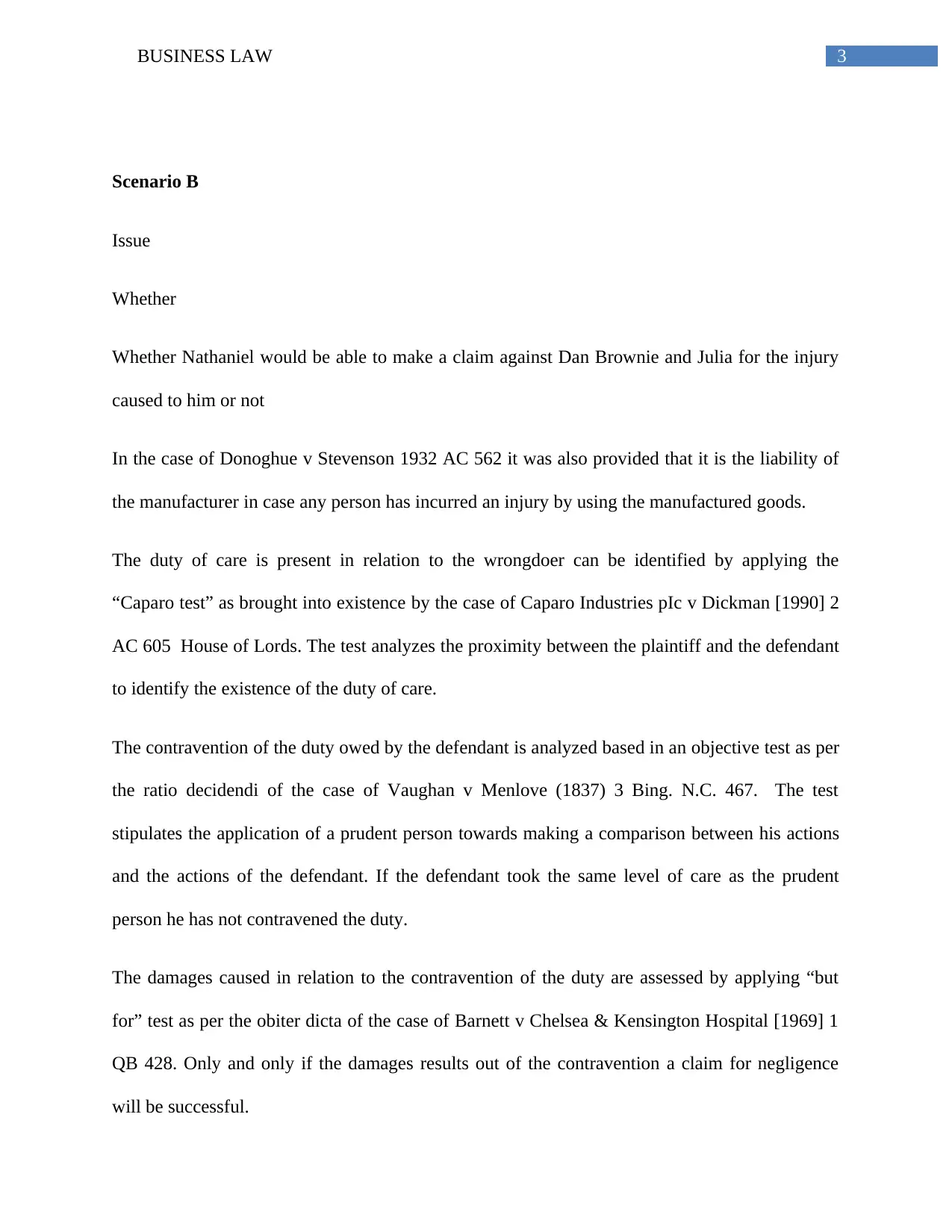
3BUSINESS LAW
Scenario B
Issue
Whether
Whether Nathaniel would be able to make a claim against Dan Brownie and Julia for the injury
caused to him or not
In the case of Donoghue v Stevenson 1932 AC 562 it was also provided that it is the liability of
the manufacturer in case any person has incurred an injury by using the manufactured goods.
The duty of care is present in relation to the wrongdoer can be identified by applying the
“Caparo test” as brought into existence by the case of Caparo Industries pIc v Dickman [1990] 2
AC 605 House of Lords. The test analyzes the proximity between the plaintiff and the defendant
to identify the existence of the duty of care.
The contravention of the duty owed by the defendant is analyzed based in an objective test as per
the ratio decidendi of the case of Vaughan v Menlove (1837) 3 Bing. N.C. 467. The test
stipulates the application of a prudent person towards making a comparison between his actions
and the actions of the defendant. If the defendant took the same level of care as the prudent
person he has not contravened the duty.
The damages caused in relation to the contravention of the duty are assessed by applying “but
for” test as per the obiter dicta of the case of Barnett v Chelsea & Kensington Hospital [1969] 1
QB 428. Only and only if the damages results out of the contravention a claim for negligence
will be successful.
Scenario B
Issue
Whether
Whether Nathaniel would be able to make a claim against Dan Brownie and Julia for the injury
caused to him or not
In the case of Donoghue v Stevenson 1932 AC 562 it was also provided that it is the liability of
the manufacturer in case any person has incurred an injury by using the manufactured goods.
The duty of care is present in relation to the wrongdoer can be identified by applying the
“Caparo test” as brought into existence by the case of Caparo Industries pIc v Dickman [1990] 2
AC 605 House of Lords. The test analyzes the proximity between the plaintiff and the defendant
to identify the existence of the duty of care.
The contravention of the duty owed by the defendant is analyzed based in an objective test as per
the ratio decidendi of the case of Vaughan v Menlove (1837) 3 Bing. N.C. 467. The test
stipulates the application of a prudent person towards making a comparison between his actions
and the actions of the defendant. If the defendant took the same level of care as the prudent
person he has not contravened the duty.
The damages caused in relation to the contravention of the duty are assessed by applying “but
for” test as per the obiter dicta of the case of Barnett v Chelsea & Kensington Hospital [1969] 1
QB 428. Only and only if the damages results out of the contravention a claim for negligence
will be successful.
Paraphrase This Document
Need a fresh take? Get an instant paraphrase of this document with our AI Paraphraser
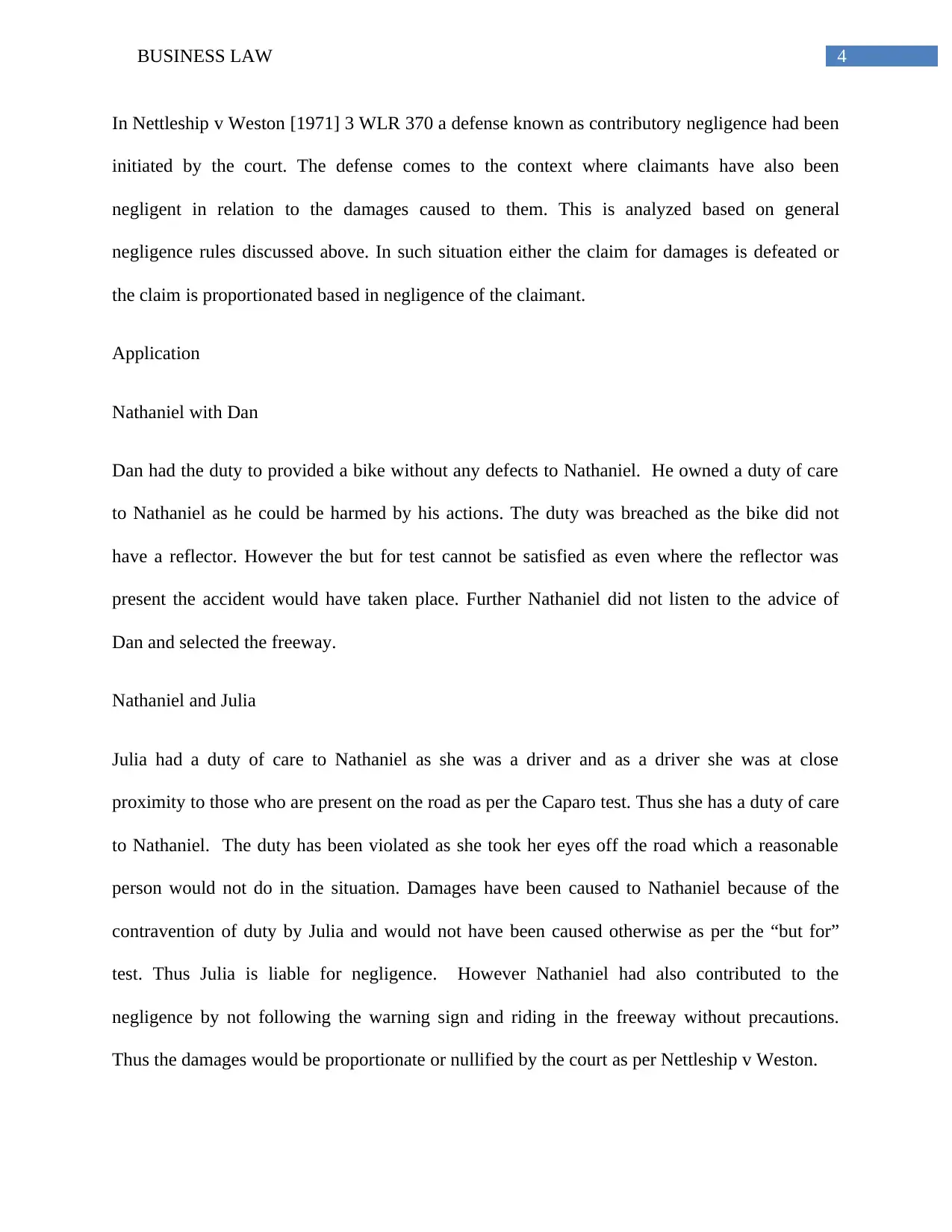
4BUSINESS LAW
In Nettleship v Weston [1971] 3 WLR 370 a defense known as contributory negligence had been
initiated by the court. The defense comes to the context where claimants have also been
negligent in relation to the damages caused to them. This is analyzed based on general
negligence rules discussed above. In such situation either the claim for damages is defeated or
the claim is proportionated based in negligence of the claimant.
Application
Nathaniel with Dan
Dan had the duty to provided a bike without any defects to Nathaniel. He owned a duty of care
to Nathaniel as he could be harmed by his actions. The duty was breached as the bike did not
have a reflector. However the but for test cannot be satisfied as even where the reflector was
present the accident would have taken place. Further Nathaniel did not listen to the advice of
Dan and selected the freeway.
Nathaniel and Julia
Julia had a duty of care to Nathaniel as she was a driver and as a driver she was at close
proximity to those who are present on the road as per the Caparo test. Thus she has a duty of care
to Nathaniel. The duty has been violated as she took her eyes off the road which a reasonable
person would not do in the situation. Damages have been caused to Nathaniel because of the
contravention of duty by Julia and would not have been caused otherwise as per the “but for”
test. Thus Julia is liable for negligence. However Nathaniel had also contributed to the
negligence by not following the warning sign and riding in the freeway without precautions.
Thus the damages would be proportionate or nullified by the court as per Nettleship v Weston.
In Nettleship v Weston [1971] 3 WLR 370 a defense known as contributory negligence had been
initiated by the court. The defense comes to the context where claimants have also been
negligent in relation to the damages caused to them. This is analyzed based on general
negligence rules discussed above. In such situation either the claim for damages is defeated or
the claim is proportionated based in negligence of the claimant.
Application
Nathaniel with Dan
Dan had the duty to provided a bike without any defects to Nathaniel. He owned a duty of care
to Nathaniel as he could be harmed by his actions. The duty was breached as the bike did not
have a reflector. However the but for test cannot be satisfied as even where the reflector was
present the accident would have taken place. Further Nathaniel did not listen to the advice of
Dan and selected the freeway.
Nathaniel and Julia
Julia had a duty of care to Nathaniel as she was a driver and as a driver she was at close
proximity to those who are present on the road as per the Caparo test. Thus she has a duty of care
to Nathaniel. The duty has been violated as she took her eyes off the road which a reasonable
person would not do in the situation. Damages have been caused to Nathaniel because of the
contravention of duty by Julia and would not have been caused otherwise as per the “but for”
test. Thus Julia is liable for negligence. However Nathaniel had also contributed to the
negligence by not following the warning sign and riding in the freeway without precautions.
Thus the damages would be proportionate or nullified by the court as per Nettleship v Weston.
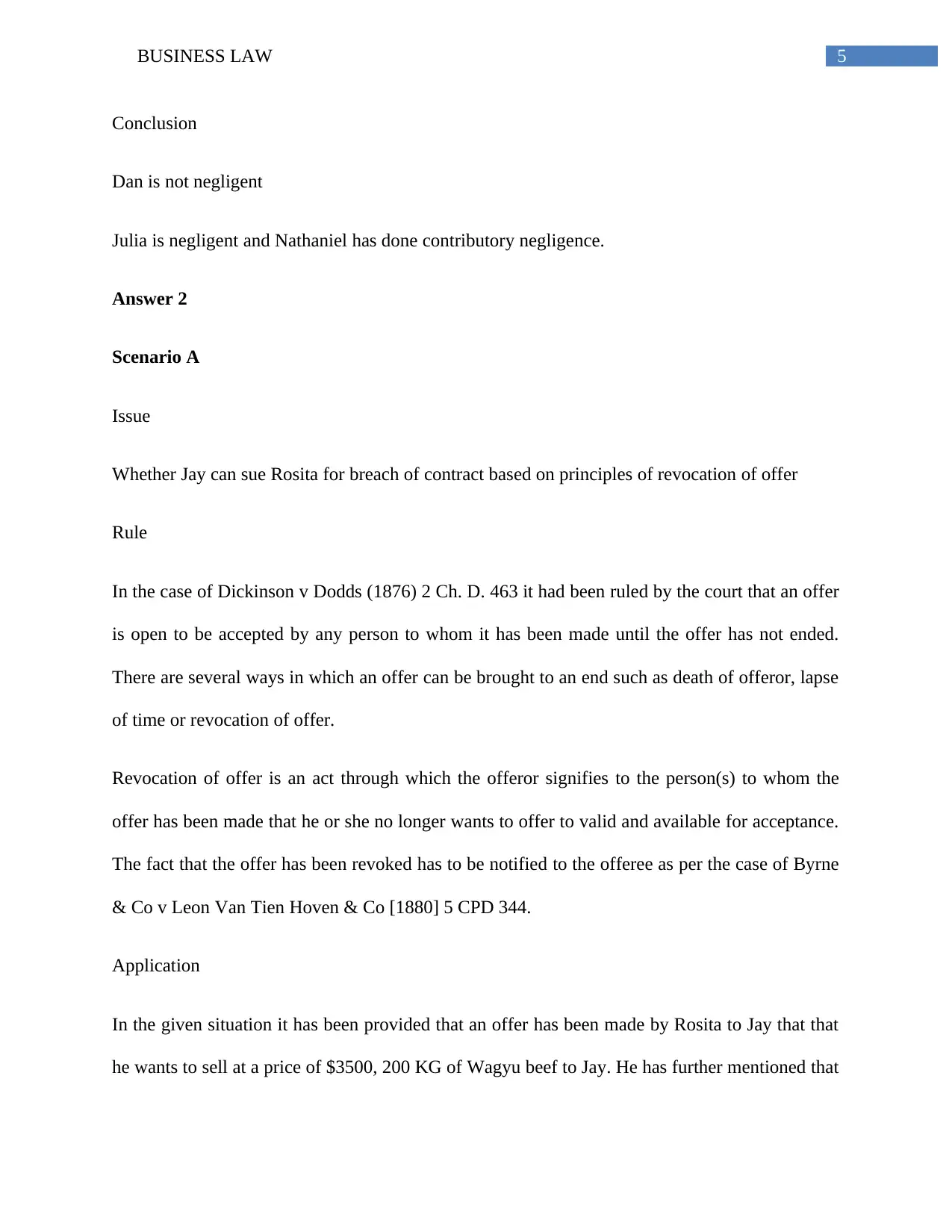
5BUSINESS LAW
Conclusion
Dan is not negligent
Julia is negligent and Nathaniel has done contributory negligence.
Answer 2
Scenario A
Issue
Whether Jay can sue Rosita for breach of contract based on principles of revocation of offer
Rule
In the case of Dickinson v Dodds (1876) 2 Ch. D. 463 it had been ruled by the court that an offer
is open to be accepted by any person to whom it has been made until the offer has not ended.
There are several ways in which an offer can be brought to an end such as death of offeror, lapse
of time or revocation of offer.
Revocation of offer is an act through which the offeror signifies to the person(s) to whom the
offer has been made that he or she no longer wants to offer to valid and available for acceptance.
The fact that the offer has been revoked has to be notified to the offeree as per the case of Byrne
& Co v Leon Van Tien Hoven & Co [1880] 5 CPD 344.
Application
In the given situation it has been provided that an offer has been made by Rosita to Jay that that
he wants to sell at a price of $3500, 200 KG of Wagyu beef to Jay. He has further mentioned that
Conclusion
Dan is not negligent
Julia is negligent and Nathaniel has done contributory negligence.
Answer 2
Scenario A
Issue
Whether Jay can sue Rosita for breach of contract based on principles of revocation of offer
Rule
In the case of Dickinson v Dodds (1876) 2 Ch. D. 463 it had been ruled by the court that an offer
is open to be accepted by any person to whom it has been made until the offer has not ended.
There are several ways in which an offer can be brought to an end such as death of offeror, lapse
of time or revocation of offer.
Revocation of offer is an act through which the offeror signifies to the person(s) to whom the
offer has been made that he or she no longer wants to offer to valid and available for acceptance.
The fact that the offer has been revoked has to be notified to the offeree as per the case of Byrne
& Co v Leon Van Tien Hoven & Co [1880] 5 CPD 344.
Application
In the given situation it has been provided that an offer has been made by Rosita to Jay that that
he wants to sell at a price of $3500, 200 KG of Wagyu beef to Jay. He has further mentioned that
⊘ This is a preview!⊘
Do you want full access?
Subscribe today to unlock all pages.

Trusted by 1+ million students worldwide
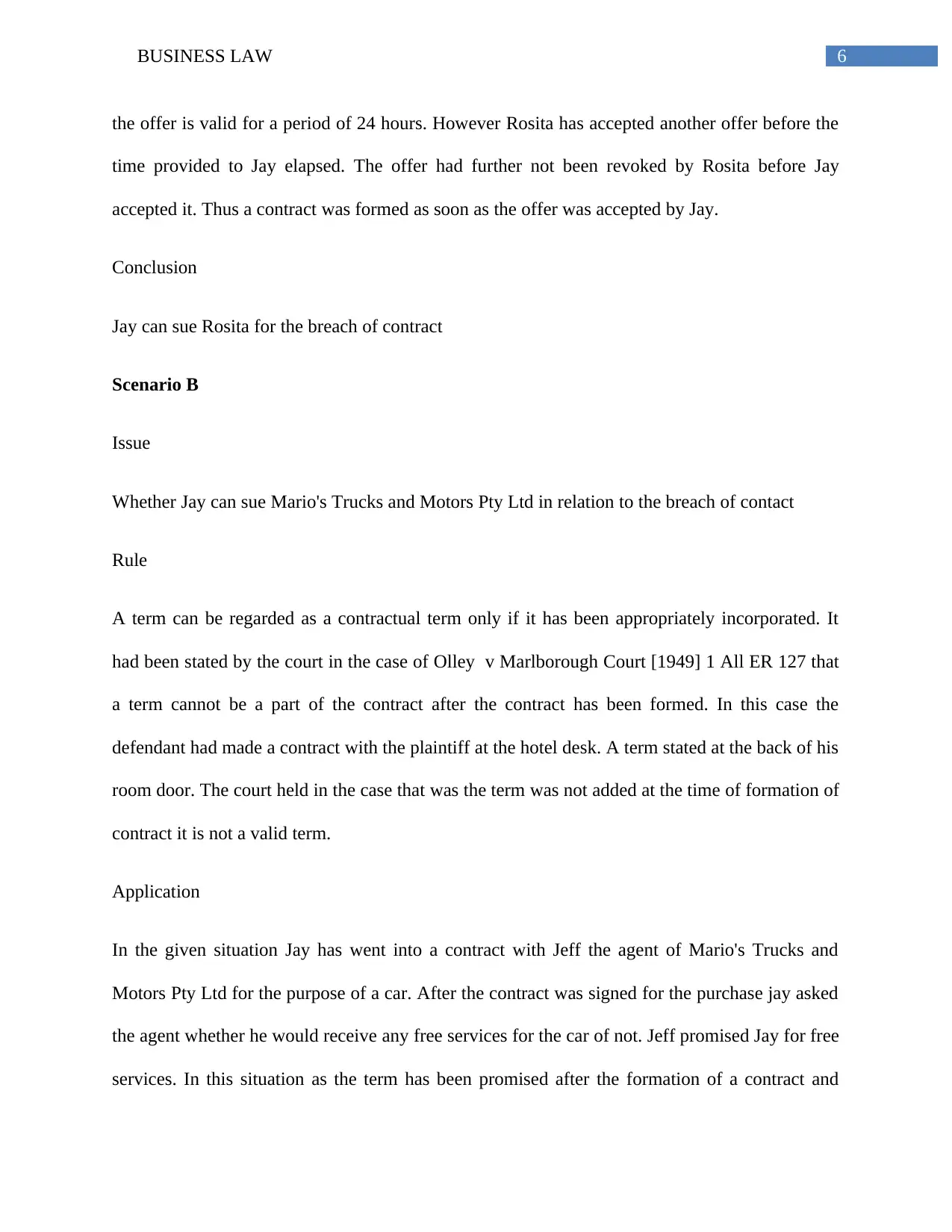
6BUSINESS LAW
the offer is valid for a period of 24 hours. However Rosita has accepted another offer before the
time provided to Jay elapsed. The offer had further not been revoked by Rosita before Jay
accepted it. Thus a contract was formed as soon as the offer was accepted by Jay.
Conclusion
Jay can sue Rosita for the breach of contract
Scenario B
Issue
Whether Jay can sue Mario's Trucks and Motors Pty Ltd in relation to the breach of contact
Rule
A term can be regarded as a contractual term only if it has been appropriately incorporated. It
had been stated by the court in the case of Olley v Marlborough Court [1949] 1 All ER 127 that
a term cannot be a part of the contract after the contract has been formed. In this case the
defendant had made a contract with the plaintiff at the hotel desk. A term stated at the back of his
room door. The court held in the case that was the term was not added at the time of formation of
contract it is not a valid term.
Application
In the given situation Jay has went into a contract with Jeff the agent of Mario's Trucks and
Motors Pty Ltd for the purpose of a car. After the contract was signed for the purchase jay asked
the agent whether he would receive any free services for the car of not. Jeff promised Jay for free
services. In this situation as the term has been promised after the formation of a contract and
the offer is valid for a period of 24 hours. However Rosita has accepted another offer before the
time provided to Jay elapsed. The offer had further not been revoked by Rosita before Jay
accepted it. Thus a contract was formed as soon as the offer was accepted by Jay.
Conclusion
Jay can sue Rosita for the breach of contract
Scenario B
Issue
Whether Jay can sue Mario's Trucks and Motors Pty Ltd in relation to the breach of contact
Rule
A term can be regarded as a contractual term only if it has been appropriately incorporated. It
had been stated by the court in the case of Olley v Marlborough Court [1949] 1 All ER 127 that
a term cannot be a part of the contract after the contract has been formed. In this case the
defendant had made a contract with the plaintiff at the hotel desk. A term stated at the back of his
room door. The court held in the case that was the term was not added at the time of formation of
contract it is not a valid term.
Application
In the given situation Jay has went into a contract with Jeff the agent of Mario's Trucks and
Motors Pty Ltd for the purpose of a car. After the contract was signed for the purchase jay asked
the agent whether he would receive any free services for the car of not. Jeff promised Jay for free
services. In this situation as the term has been promised after the formation of a contract and
Paraphrase This Document
Need a fresh take? Get an instant paraphrase of this document with our AI Paraphraser
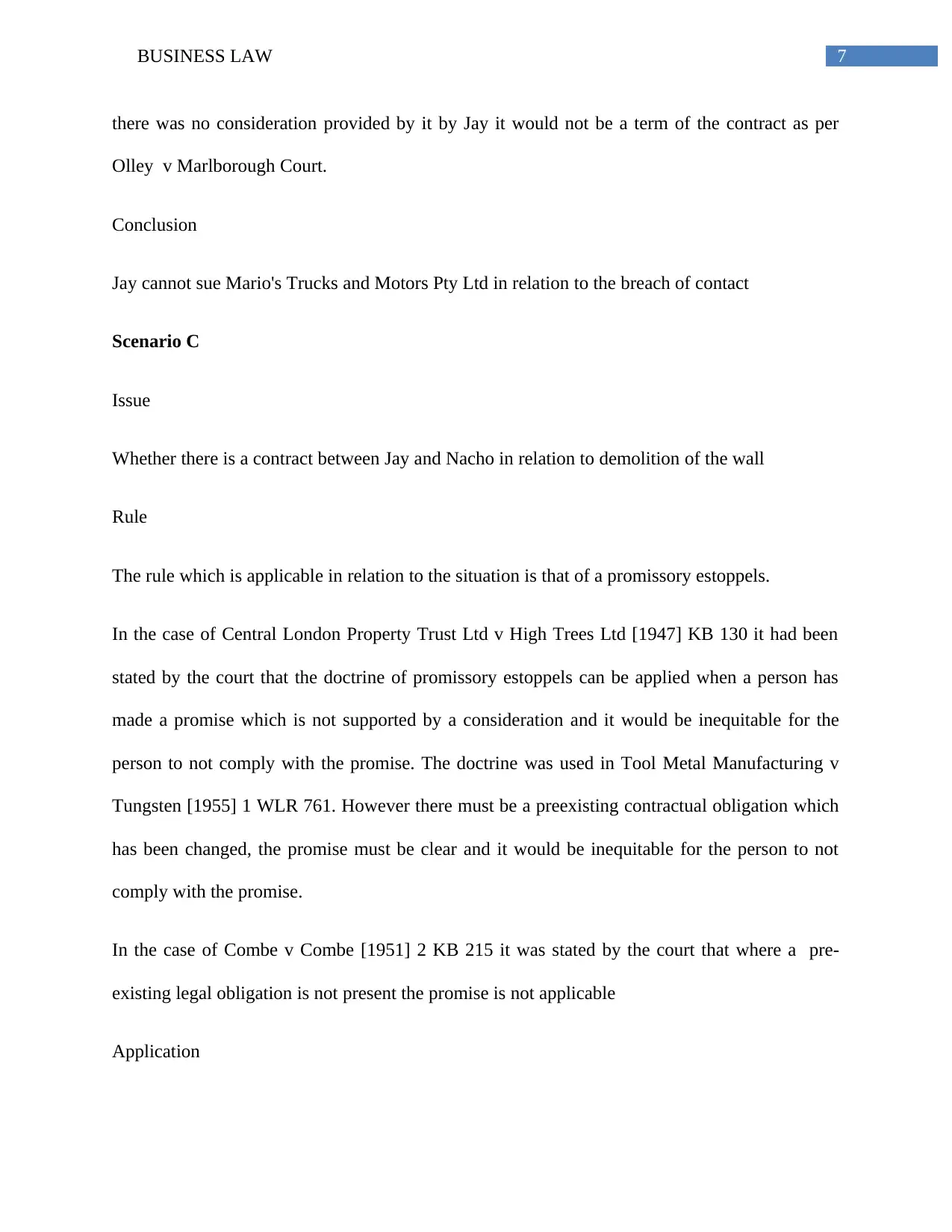
7BUSINESS LAW
there was no consideration provided by it by Jay it would not be a term of the contract as per
Olley v Marlborough Court.
Conclusion
Jay cannot sue Mario's Trucks and Motors Pty Ltd in relation to the breach of contact
Scenario C
Issue
Whether there is a contract between Jay and Nacho in relation to demolition of the wall
Rule
The rule which is applicable in relation to the situation is that of a promissory estoppels.
In the case of Central London Property Trust Ltd v High Trees Ltd [1947] KB 130 it had been
stated by the court that the doctrine of promissory estoppels can be applied when a person has
made a promise which is not supported by a consideration and it would be inequitable for the
person to not comply with the promise. The doctrine was used in Tool Metal Manufacturing v
Tungsten [1955] 1 WLR 761. However there must be a preexisting contractual obligation which
has been changed, the promise must be clear and it would be inequitable for the person to not
comply with the promise.
In the case of Combe v Combe [1951] 2 KB 215 it was stated by the court that where a pre-
existing legal obligation is not present the promise is not applicable
Application
there was no consideration provided by it by Jay it would not be a term of the contract as per
Olley v Marlborough Court.
Conclusion
Jay cannot sue Mario's Trucks and Motors Pty Ltd in relation to the breach of contact
Scenario C
Issue
Whether there is a contract between Jay and Nacho in relation to demolition of the wall
Rule
The rule which is applicable in relation to the situation is that of a promissory estoppels.
In the case of Central London Property Trust Ltd v High Trees Ltd [1947] KB 130 it had been
stated by the court that the doctrine of promissory estoppels can be applied when a person has
made a promise which is not supported by a consideration and it would be inequitable for the
person to not comply with the promise. The doctrine was used in Tool Metal Manufacturing v
Tungsten [1955] 1 WLR 761. However there must be a preexisting contractual obligation which
has been changed, the promise must be clear and it would be inequitable for the person to not
comply with the promise.
In the case of Combe v Combe [1951] 2 KB 215 it was stated by the court that where a pre-
existing legal obligation is not present the promise is not applicable
Application
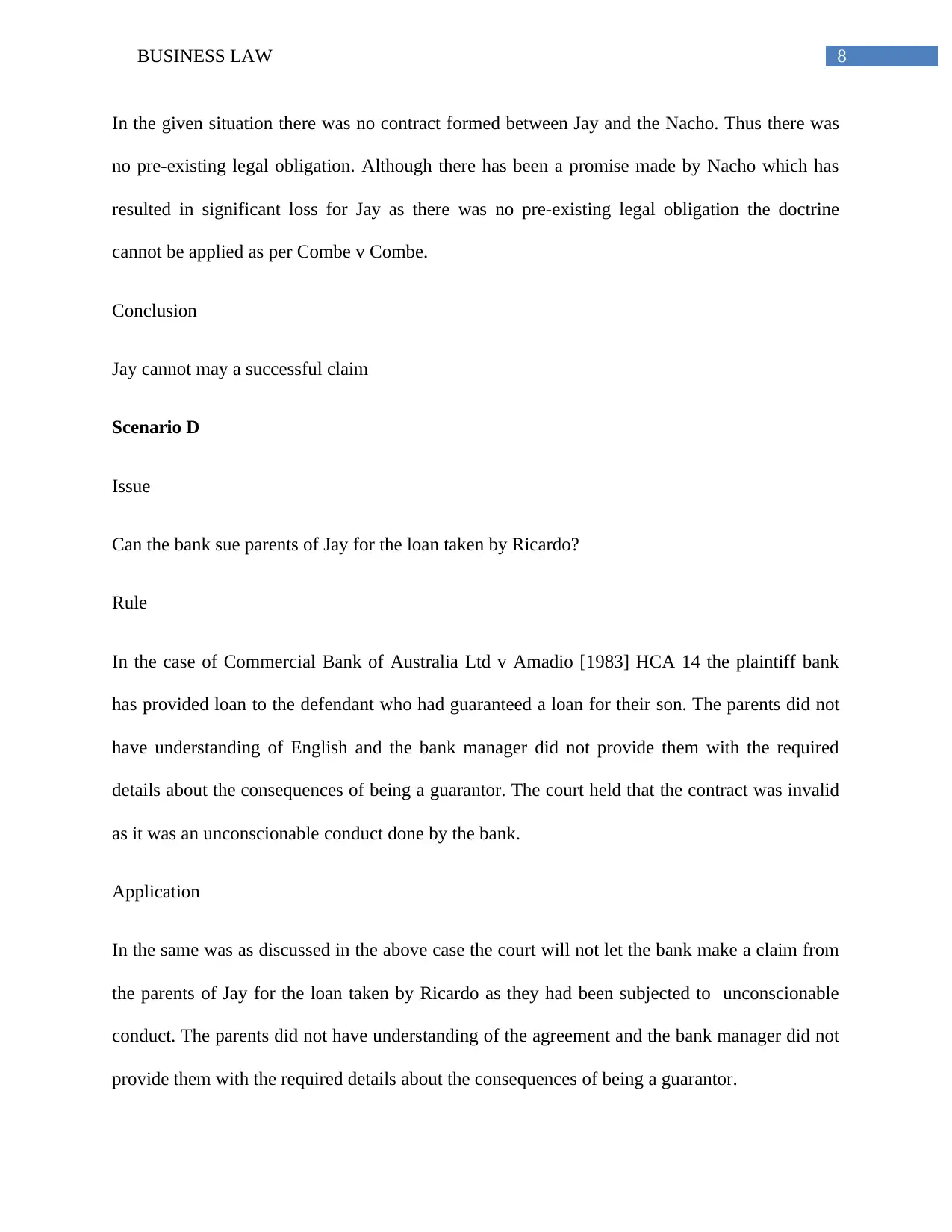
8BUSINESS LAW
In the given situation there was no contract formed between Jay and the Nacho. Thus there was
no pre-existing legal obligation. Although there has been a promise made by Nacho which has
resulted in significant loss for Jay as there was no pre-existing legal obligation the doctrine
cannot be applied as per Combe v Combe.
Conclusion
Jay cannot may a successful claim
Scenario D
Issue
Can the bank sue parents of Jay for the loan taken by Ricardo?
Rule
In the case of Commercial Bank of Australia Ltd v Amadio [1983] HCA 14 the plaintiff bank
has provided loan to the defendant who had guaranteed a loan for their son. The parents did not
have understanding of English and the bank manager did not provide them with the required
details about the consequences of being a guarantor. The court held that the contract was invalid
as it was an unconscionable conduct done by the bank.
Application
In the same was as discussed in the above case the court will not let the bank make a claim from
the parents of Jay for the loan taken by Ricardo as they had been subjected to unconscionable
conduct. The parents did not have understanding of the agreement and the bank manager did not
provide them with the required details about the consequences of being a guarantor.
In the given situation there was no contract formed between Jay and the Nacho. Thus there was
no pre-existing legal obligation. Although there has been a promise made by Nacho which has
resulted in significant loss for Jay as there was no pre-existing legal obligation the doctrine
cannot be applied as per Combe v Combe.
Conclusion
Jay cannot may a successful claim
Scenario D
Issue
Can the bank sue parents of Jay for the loan taken by Ricardo?
Rule
In the case of Commercial Bank of Australia Ltd v Amadio [1983] HCA 14 the plaintiff bank
has provided loan to the defendant who had guaranteed a loan for their son. The parents did not
have understanding of English and the bank manager did not provide them with the required
details about the consequences of being a guarantor. The court held that the contract was invalid
as it was an unconscionable conduct done by the bank.
Application
In the same was as discussed in the above case the court will not let the bank make a claim from
the parents of Jay for the loan taken by Ricardo as they had been subjected to unconscionable
conduct. The parents did not have understanding of the agreement and the bank manager did not
provide them with the required details about the consequences of being a guarantor.
⊘ This is a preview!⊘
Do you want full access?
Subscribe today to unlock all pages.

Trusted by 1+ million students worldwide
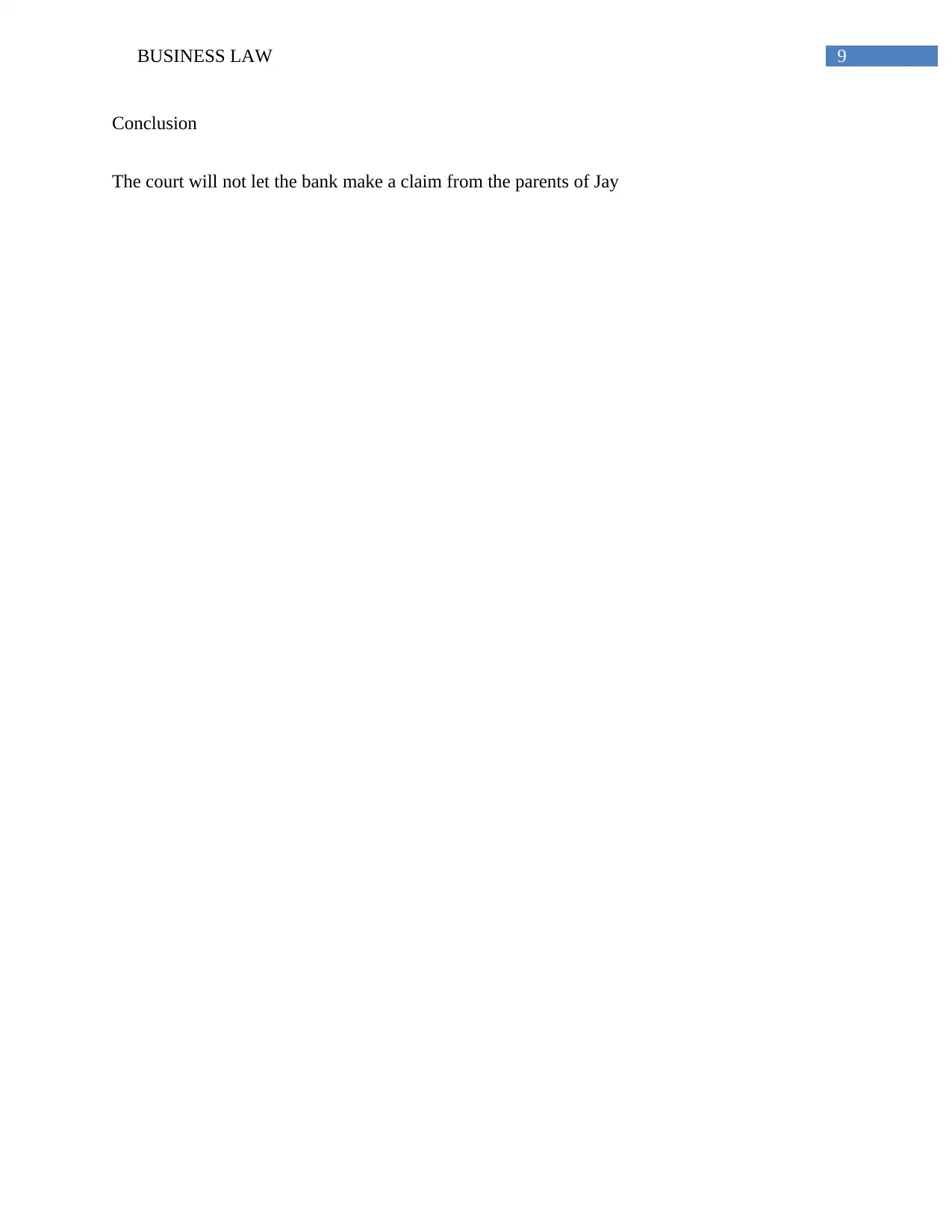
9BUSINESS LAW
Conclusion
The court will not let the bank make a claim from the parents of Jay
Conclusion
The court will not let the bank make a claim from the parents of Jay
Paraphrase This Document
Need a fresh take? Get an instant paraphrase of this document with our AI Paraphraser
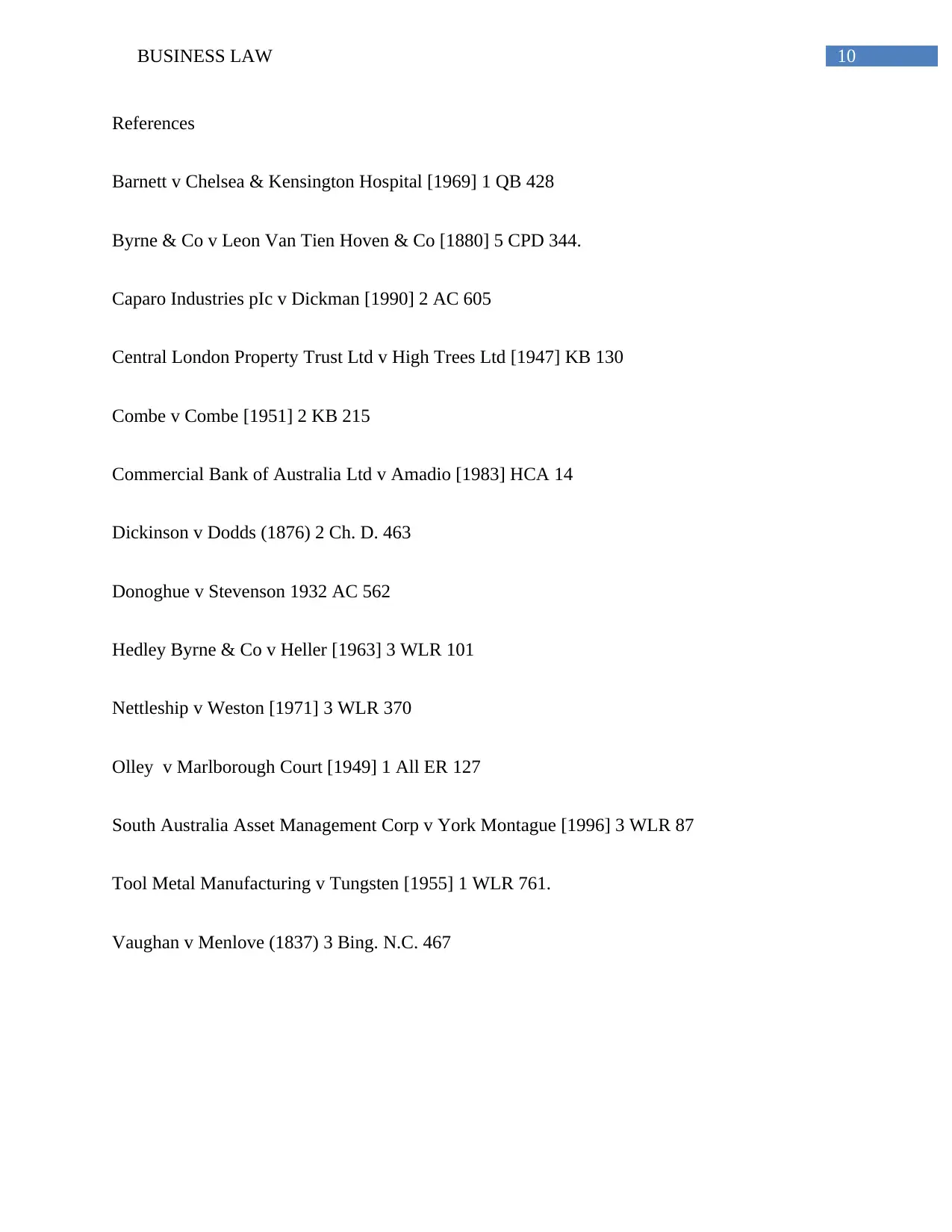
10BUSINESS LAW
References
Barnett v Chelsea & Kensington Hospital [1969] 1 QB 428
Byrne & Co v Leon Van Tien Hoven & Co [1880] 5 CPD 344.
Caparo Industries pIc v Dickman [1990] 2 AC 605
Central London Property Trust Ltd v High Trees Ltd [1947] KB 130
Combe v Combe [1951] 2 KB 215
Commercial Bank of Australia Ltd v Amadio [1983] HCA 14
Dickinson v Dodds (1876) 2 Ch. D. 463
Donoghue v Stevenson 1932 AC 562
Hedley Byrne & Co v Heller [1963] 3 WLR 101
Nettleship v Weston [1971] 3 WLR 370
Olley v Marlborough Court [1949] 1 All ER 127
South Australia Asset Management Corp v York Montague [1996] 3 WLR 87
Tool Metal Manufacturing v Tungsten [1955] 1 WLR 761.
Vaughan v Menlove (1837) 3 Bing. N.C. 467
References
Barnett v Chelsea & Kensington Hospital [1969] 1 QB 428
Byrne & Co v Leon Van Tien Hoven & Co [1880] 5 CPD 344.
Caparo Industries pIc v Dickman [1990] 2 AC 605
Central London Property Trust Ltd v High Trees Ltd [1947] KB 130
Combe v Combe [1951] 2 KB 215
Commercial Bank of Australia Ltd v Amadio [1983] HCA 14
Dickinson v Dodds (1876) 2 Ch. D. 463
Donoghue v Stevenson 1932 AC 562
Hedley Byrne & Co v Heller [1963] 3 WLR 101
Nettleship v Weston [1971] 3 WLR 370
Olley v Marlborough Court [1949] 1 All ER 127
South Australia Asset Management Corp v York Montague [1996] 3 WLR 87
Tool Metal Manufacturing v Tungsten [1955] 1 WLR 761.
Vaughan v Menlove (1837) 3 Bing. N.C. 467
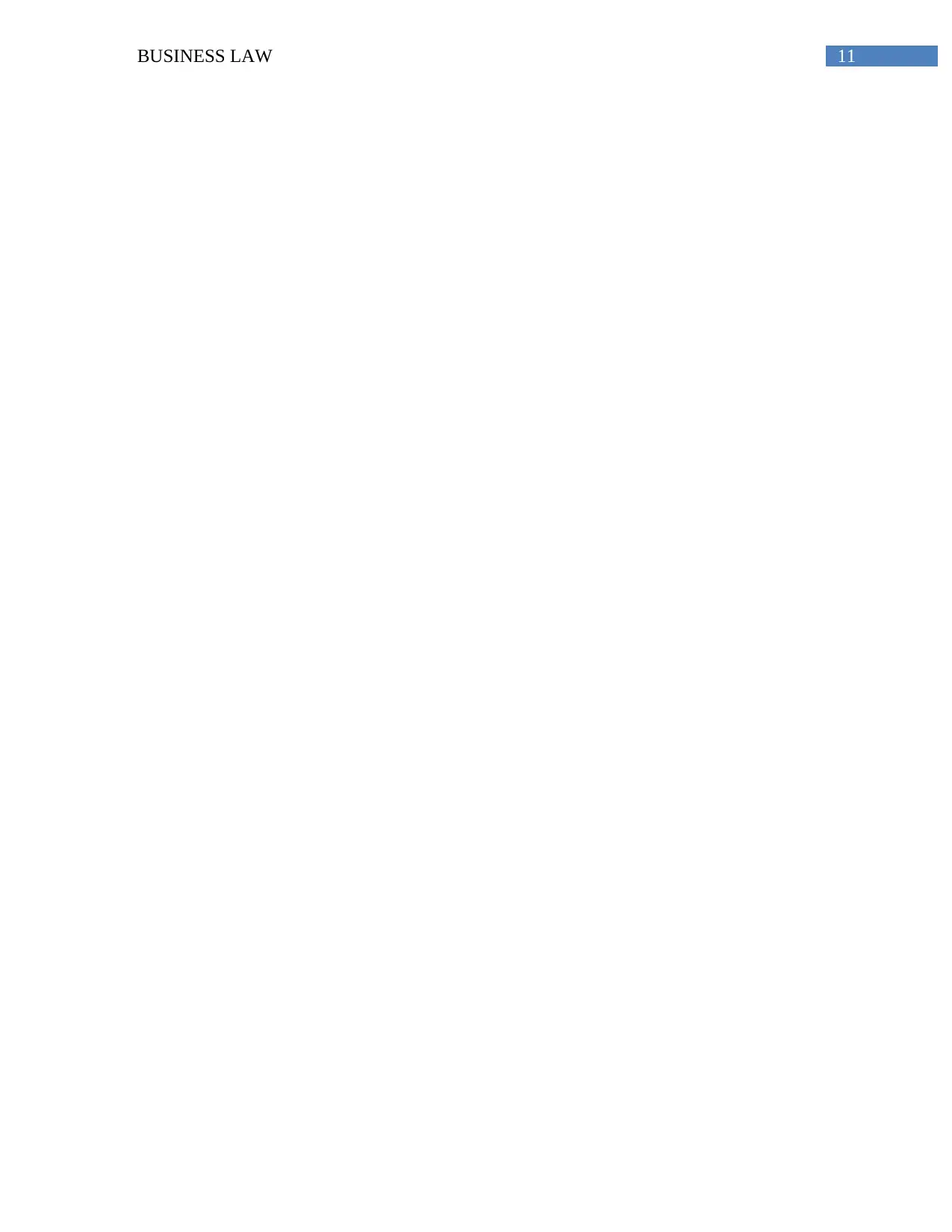
11BUSINESS LAW
⊘ This is a preview!⊘
Do you want full access?
Subscribe today to unlock all pages.

Trusted by 1+ million students worldwide
1 out of 12
Related Documents
Your All-in-One AI-Powered Toolkit for Academic Success.
+13062052269
info@desklib.com
Available 24*7 on WhatsApp / Email
![[object Object]](/_next/static/media/star-bottom.7253800d.svg)
Unlock your academic potential
Copyright © 2020–2025 A2Z Services. All Rights Reserved. Developed and managed by ZUCOL.




